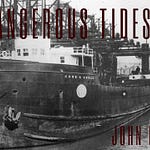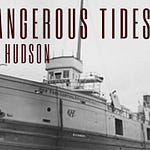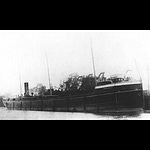Today, we’re going to examine the mysterious loss of the SS Benjamin Noble, a ship that, over 110 years after she foundered, still continues to fascinate people the whole world over. Many wonder exactly what could have been done to prevent such a loss, poring over the documents of the initial lawsuit that followed her foundering off the Knife River in Minnesota, as well as some of the last messages the crew sent out before losing their lives on Lake Superior. What exactly caused her sinking? Was it the early year gale? Was it a lack of experience on the captain’s part? Was it the overconfidence of those who mastered the canal locks she passed through? Or was it simply the unpredictable nature of Lake Superior, a lake that is so dangerous to sail, it is confirmed that once you die on the lake, you will never be recovered? Climb aboard as we set sail on Dangerous Tides.
In the year of 1914, a small freighter company, Capitol Transport, owned only one ship, but given recent profits despite a massive economic recession, CTC was looking to expand their fleet. Built in 1909 in Wyandotte, Michigan, the Benjamin Noble was named for one of CTC’s primary investors. The Benjamin Noble would be classified as a canaller, much like the Kamloops and other ships we’ve covered on Dangerous Tides, due to being designed to pass the Welland Canal as they took shipments out to the mainland United States and Canada.
The Noble was said to have a unique design that was unlike the standard canalers of her day. Like most cargo canalers, she had a low cargo deck to ease transport of materials, in this case, steel for the railways of America. Unlike most canalers, however, the cabins were elevated on the poop deck of the stern and the forecastle deck of the bow. Despite these features being meant to ease the transport of steel, it also meant the cargo deck was often awash in lake water and sat very low for the standards. Despite having solid-sided bulwark rails to keep the cargo in place, with large scuppers for drainage, this also meant water could easily be trapped on deck, adding to the top-heaviness should a hatch cover fail.
The Noble was designed to transport pulpwood for paper mills in the area, a much lighter load than what the Noble would be saddled with on April of the 1914 season. The Capitol Transport Company was looking to diversify its cargo, but lost the captain of the Noble beforehand.
John A. Francombe Jr., the owner of Capitol Transport, had underbid a contract to carry rails from Ashtabula, Ohio to Duluth, Minnesota. In order to prevent additional losses, all the rails had to be brought out in one trip, so he was in need of a new captain for the Noble. Enter the young John Eisenhardt, who despite having experience as a first mate in other ships, had no experience as captain. However, Eisenhardt had grown up on the Great Lakes and was well-liked by the crew. At the age of 31, he was the youngest captain on record of the service to the Great Lakes.
The first trip of the season for the Noble, this was also his first commission as Captain, watching steadfastly for six days as the rails were loaded onto the freighter.
Upon arrival at Cleveland, 60 railcars’ worth of steel railing for The Great Northern Railway sat on the docks ready for transport. Eisenhardt had the presence of mind to ask how much to load on the cargo deck, to which the harbor master replied “You’re the captain. Look in the logbooks and see what your ship took before.” So, upon further inspection, Eisenhardt found that 55 cars’ worth of railing was taken before, so Eisenhardt made a call back to Detroit and said “Listen, let’s put a little more railing on there.” He told the dockworker loading the rails. “I have to do this, or they’ll think I got cold feet.”
As each rail was loaded, the cargo deck started to sink deeper into the lake. As a new captain, Eisenhardt had a difficult time stopping the loading or refusing to take the load without jeopardizing his career. There were also no Coast Guard regulations to keep a ship from leaving port if she was overloaded, so all the responsibility fell to Eisenhardt.
By the time the Noble left port, the cargo deck was so overloaded the anchors were partially submerged and the cargo deck nearly hit the water level. None of the crew refused to sail on that April day, as they knew if they chose to quit, there would be lines of sailors waiting to take over their duties. While astonished dockworkers looked on to watch the Noble leave port, Captain Eisenhardt assured them that he would hug the shore all the way to Duluth to avoid any inclement weather. The dockworkers were so astonished that the Noble took such a load, one of them, Guy Klump, took the last known photograph of the ship with his Kodak.
Upon arrival in Detroit, steamboat inspectors had arrived to assess whether the Noble would be seaworthy to continue the trip. The story was that the Noble’s cargo deck was thoroughly wet, so much so, the inspectors had to put galoshes on. Despite the unsafe conditions and clearly being ill-equipped to handle the load of railing, no one questioned the captain. The workers at the Soo locks would testify in a later court case that this was the most overloaded ship they had seen in their time working there. At the time, it was unthinkable to challenge the captain, ever, on the ship, but it is worth speculating why the dockworkers didn’t stop the ship, especially where they had some authority to tell the captain he should look at the safety of the ship.
Eisenhardt’s plan seemed to work, as he almost made it to his destination, up until he rounded Devil’s Island on the 28th of April. Still, he pressed on, redirecting the course straight for Duluth. What happened next could only be surmised as the storm brewed in an area where there was no leeway for the Noble. The maximum speed the ship could take was estimated to be about 8 knots, or 9.2 mph. At such a slow speed, the waves would be crashing over the cargo deck and sinking the Noble deeper into the lake. The hatch covers would blow off the bulwark railing and cause the Noble to take on more water. In the blinding snowstorm that night, crewmen of two other ships thought that they saw the Noble’s lights disappearing that night, but had no idea whether it was due to poor visibility or trouble. Those ships that had followed the Noble were a lumber freighter by the name of Norwalk, which struggled into Duluth harbor at 4:30 am, and the Daniel J. Morrell, who would break up in Lake Huron 52 years later.
Newspaper reports would be hazy up until the next afternoon. One sailor claimed he saw the Noble turning to the seas before losing sight of her. One woman claimed she saw the Noble making it to port in Duluth but turned around as one of the entry lights was out. A lighthouse keeper also speculated that an unknown ship was waved off twice as it was attempting to enter the shelter of Two Harbors. It wasn’t until hatch covers, rafts, and debris from the Noble would wash ashore at Park Point that the fate of the Noble would be revealed. A bottle was amongst the debris with a note written by one of the crew members, saying how far offshore they were, mentioning how close they were to Duluth, and accepting that the Noble would be lost for good.
A subsequent lawsuit surrounding the loss of the Noble and her estimated 20 crew members revealed most of the details of the incident, along with further dives to the ship after she was discovered in 2004. The Capitol Transportation Company would lose the lawsuit after it was revealed the conditions were not safe to transport in by dockworkers, sailors, and citizens who testified in the trial. Francombe admitted that had he been aware that Eisenhardt had taken on so much cargo and would lose the entire load, he would not have allowed him to leave port.
A few years after the Benjamin Noble was discovered, it was found that the load was so heavy, the ship became partially buried in silt upon hitting the bottom. The hull itself had cracked in two just forward of the boiler room, and all the cabins had collapsed due to the combined weight of the water and the now-exposed cargo, which is partially covered in silt. Jerry Eliason and Ken Merryman, along with two other divers, all having a long history of identifying and exploring shipwrecks of the Great Lakes, surmised with the legal and maritime experts that the Noble had crashed so hard, the ship itself skewered into the lake bottom.
Thank you for joining us today. This episode is dedicated to the memory of all 20 crew members who lay in the Noble off the bottom of Knife River, as well as the efforts of the divers, historians, and maritime experts to make these episodes happen. May fair winds guide on Dangerous Tides.
Sources:
https://www.superiortrips.com/NShoreShipwreckImages/Ben_Noble.htm
https://www.mnhs.org/splitrock/learn/shipwrecks
http://news.minnesota.publicradio.org/features/2005/07/20_hemphills_superiorwreck/
https://www.c-span.org/classroom/document/?20419
https://search.library.wisc.edu/digital/A2UGD5RLGSPP7J84
Photos













Share this post